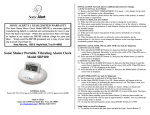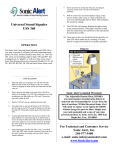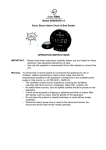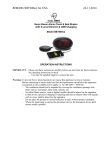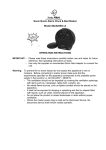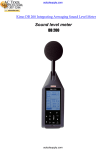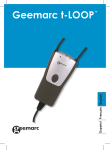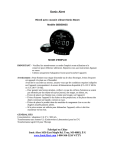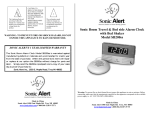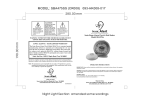Download Operation DB200 Signaler DB Sensor Setting the Dip
Transcript
DB200 Signaler DB Sensor WIRELESS DOORBELL & TELEPHONE SIGNALER MODEL DB200 SONIC ALERT’S 5 YEAR LIMITED WARRANTY The Wireless Doorbell & Telephone Signaler Model DB200 is warranted against manufacturing defects INSTALLATION the date of purchase. Within this period Sonic Alert To install the DB200, follow the diagrams and instructions on the following page that match the type of installation you need for your home. If the installation follows diagrams 1-3, a 12-volt alkaline battery is required in the DB sensor. in materials and workmanship for five (5) years from will replace at our option the DB200 without charge for parts and labor. Simply send the DB200 (postpaid) and a copy of your sales slip as proof of purchase to: Sonic Alert Inc., 1050 E. Maple Road, Troy MI 48083 Please check the switches on your DB Sensor before installing. Do not change switches 1-6. These are pre-set. Setting the Dip Switches: Operation The state-of-the-art, Doorbell & Telephone Signaler will alert you when someone comes to visit. The DB200 is the only doorbell and intercom signaler that does not require wires and can be installed in seconds. DB200 signaler will alert you that someone is at your door or calling your telephone by flashing a light plugged into it and any Sonic Alert receiver you may have anywhere in your home. The DB200 is designed to work in homes with or without an existing doorbell or chime and most existing buzzer and intercom systems. Selecting Flash Rate Other features include selectable number of flashes (5 or 10), different flash code for front door, rear door, or intercom. Additional sensors (DB100T, sold separately) are required for 2nd door. There is also a built-in chime for hearing members of the. The signaler receives an RF (radio) signal from the DB sensor, and flashes the light plugged into the built-in outlet of the DB200. Use a 300-watt or less incandescent lamp only. The DB200 can send a signal to all Sonic Alert remote receivers. Note: Must be used only with Sonic Alert receivers for proper operation, other manufacturers products are not reliable with our products. ON OFF 1 2 3 4 5 6 7 8 DB Sensor settings (smaller unit) dip switches 1 thru 6 are set at the factory and only need to be changed if your neighbor has a DB200 or DB100. The 8 dip switches should be set as follows: a) 1 thru 3 dip switches are set in the ON position and 4 thru 6 are set in the OFF position. If you need to change the dip switch settings to avoid interference with your neighbors make sure you change both the DB200 Signaler to match the DB Sensor. b) The 7th switch is for when you are using 2 sensors; this switch determines the settings for front or back door. If using for one door only set this switch in the ON position. At this setting your unit will flash at a fast rate and will make a ding/dong sound. If using 2 sensors one for the front door and one for the back door the setting for the 2nd sensor would be in the OFF position. In this position the front door will flash at a different flash rate than the back door. In the OFF position your back door sensor will flash at a slow rate with a ding/dong sound. c) The 8th switch determines the number of flashes when someone is at your door. In the ON position your unit will flash 5 times and in the OFF position your unit will flash 10 times. This feature is wonderful when you have an extra sensor for the back door. One sensor would be set in the ON position and the other would be set in the OFF position. Multi-Function-Input Jack: Located on the left side of the DB Sensor, this input jack is for installations as shown below in diagram 2. Setting the Audio Switch: Top - OFF Bottom - ON Located on the DB200 Signaler: The speaker switch allows you to turn the Audio Alarm ON or OFF. ON is down and OFF is up DB200 INSTALLATION DIAGRAMS Telephone Signaler Installation: See figure 4 for telephone ringer cord installation. It is necessary to use a 2 to 1 telephone adapter (can be purchased at Radio Shack or hardware stores) if plugging in a telephone or TTY in same modular outlet. Troubleshooting & Help: If you’ve followed the directions and are still having problems please try the following suggestions: 1) Check battery in the sensor must be a 12-volt alkaline type. Also do not place sensor on steel doors or steel door jams. 2) Check dip switch settings both the sensor and the signaler must match as shown in figure 1.1 above. 3) Check outlet for power. 4) Move the Signaler to an outlet closer to the sensor unit, may have exceeded range of sensor approximately 40-50 feet. 5) If using the Multi-Function input jack make sure that the wires are not touching each other. See diagram number 2 & 5 for proper installation. 6) Make sure telephone plug is plugged in firmly. For Technical help call 1-248-577-5400 M-F 7:30 a.m. - 6:00 p.m. Eastern Time Or e-mail us with your questions at [email protected] Warranty: Thank you for purchasing this high quality Sonic Alert product. We hope you will have many years of satisfied use. This Sonic Alert product comes with a limited 5-year warranty so please retain your receipt in a safe place for possible future reference; you will need in the event of warranty service. Sonic Alert, Inc. Battery free installation: Use wire provided, plug into jack outlet on side of transmitter. Remove chime cover and connect the red and yellow wires to chime box terminal screws common and front. 1050 East Maple Rd. Troy, MI 48083 V/TTY 1-248-577-5400 fax 248-577-5433 E-mail: [email protected] Web Site: www.SonicAlert.com See all our product offerings at: www.SonicAlert.com Or call for a free catalogue 1-248-577-5400 V/TTY REV 1.5 (2008) This device complies with Part 15 of the FCC Rules and with RSS-210 of Industry Canada. Operation is subject to the following two conditions: (1) This device may not cause harmful interference, and (2) This device must accept any interference received, including interference that may cause undesired operation. WARNING: Changes or modifications not expressly approved by the party responsible for compliance could void user’s authority to operate the equipment





